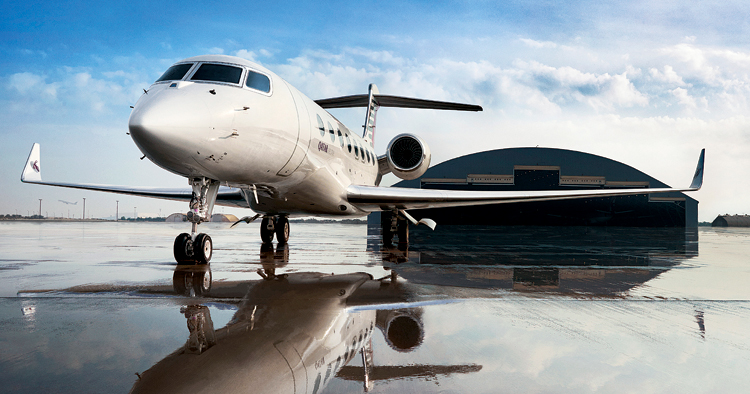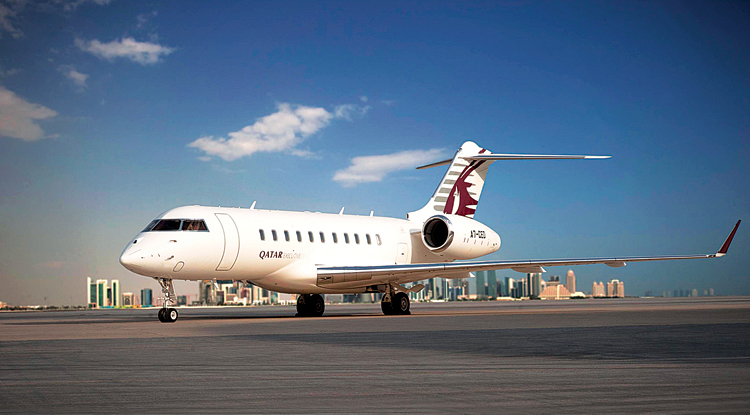Boosted by wealth concentrated in some of the countries in the Middle East, the aviation industry in the region including the business aviation segment, has generally been a success story

Emirates’ Phenom 100E aircraft
The Middle East is a transcontinental region that is made up of 16 countries, a majority of these Islamic and some endowed with enormous wealth largely attributable to oil reserves. The Middle East region has been an important market for business aviation ever since this segment of the global civil aviation industry was established. Yet in some of the countries such as Yemen, Syria and Libya business aviation is still almost non-existent. Initially, business aviation in the Middle East was an exclusive privilege for royal families and heads of state. However, over the last decade or so, there has seen a clear shift of business aviation towards corporate travel.
BUSINESS JETS IN THE MIDDLE EAST
Since the year 2004, the market for business aviation aircraft in the Middle East had been growing at compounded annual growth rate of seven per cent. However, at the end of the year 2017, the strength of the fleet of business aviation aircraft stood at 620, a figure that was two per cent lower than that for the previous year. The reduction by 12 business jets in the Saudi Arabian fleet in 2017 was the largest in the region representing a drop by 7.2 per cent. Other countries in the region where the reduction was smaller were Bahrain, Cyprus, Iran, Iraq, Kuwait and Lebanon. On the other hand there were countries in the region namely Egypt, Jordon, Qatar, Turkey and the UAE that registered marginal growth in the size of the fleet of business jets. The largest increase in fleet strength was recorded by UAE that added six aircraft to its existing fleet registering a growth rate of six per cent for the year.
The two global original equipment manufacturers (OEM) namely Bombardier and Gulfstream, dominate the business aviation market in the Middle East
The average age of the aircraft in the fleet stood at 14.6 years, an increase from 14.2 years in 2016. Data also reveals that in the last five years i.e. in the period 2012 to 2017, the fleet of business aircraft in the Middle East has grown by just under five per cent. As per some analysts, the fleet of business aircraft in the Middle East is expected to reduce by one to three per cent primarily on account of business aviation companies opting for off-shore registration. In fact, migration by owners to foreign registries, makes it difficult to arrive at an accurate figure of the total number of business aviation aircraft owned and operated by private owners and other agencies in the Middle East.
OEMS IN THE MIDDLE EAST
Five countries in the Middle East that have the largest fleets of business aviation aircraft are Saudi Arabia, Turkey, the UAE, Israel and Egypt. These five nations own around 76 per cent of the total assets in this class in the region with the first two commanding ownership of around 48 per cent of the fleet. The two global original equipment manufacturers (OEM) namely Bombardier and Gulfstream, dominate the business aviation market in the Middle East with the former commanding a market share of 19.4 per cent and the latter marginally lower at 18.3 per cent. The most widely used business jet platforms in 2017 were Bombardier Challenger 605 and the Gulfstream G550. These are now being replaced or augmented by the Challenger 650 and the Gulfstream G650. Apart from the platforms from the two major global OEMs, there are the Cessna Citation CJ and the Falcon 2000EX business jets being operated by some of the countries in the Middle East region, albeit in small numbers.

Scheduled and Non-Scheduled in Synergy: Qatar Airways’ Gulfstream G650ER under the banner of Qatar Executive
Another global OEM making inroads into the market for business aviation aircraft in the Middle East region is Embraer of Brazil. Business aviation aircraft from Embraer available to customers in the Middle East region are the top end of the company’s line, including the Legacy 600/650 and Lineage 1000 and shuttle variants. Among the Phenoms delivered to the nations of the Middle East region, Etihad has taken the first two Phenom 100Es with two more aircraft slated to come next year. For this company, the Middle East is an important market. So far the company has sold just over 50 business aviation aircraft to the region, majority of these that is 20 have gone to customers in the UAE and 12 to Saudi Arabia. As per Embraer, demand for business aviation aircraft in the Middle East region is expected to rise in 2019 and beyond and the Brazilian aerospace major sees a potential market for 200 business jets in the years to come. To support the existing fleet of Embraer business jets, the company has set up two authorised centres in the Middle East region. These are ExecuJet located in Dubai and Falcon Aviation Services in Abu Dhabi.
TYPES OF BUSINESS AVIATION AIRCRAFT
According to MEBAA, currently up to 70 per cent of flights performed by private jets within the Middle East region are for business purposes, while luxury travel accounts for the remaining 30 per cent. Nevertheless, high net-worth individuals are still the key drivers of the business aviation growth in the region. Many of the nations in the Middle East are populated by ultra high net-worth individuals who have clear preference of large size business jets. The business jet market in the Middle East thus is primarily a market for large cabin aircraft with the range long enough to fly nonstop from Dubai to London. The Middle East is situated halfway between Europe and Asia and the business tycoons prefer to fly to the major business centres in both Europe and Asia in the shortest possible time flying directly to destinations. The largest fleet of business aviation aircraft in the Middle East is located in Saudi Arabia where the ratio between large cabin and long range business jets to small size business aviation aircraft, is high. Also, the business aviation fleets include airliners converted for business travellers. These are referred to as “Bizliners”. Percentage wise, the fleet of business aviation aircraft in the Middle East has a mix of different sizes of aircraft with the large size business jets constituting 61.9 per cent, medium size at 27.3 per cent and small size light-weight business jets at a measly 10.7 per cent. Apart from Bombardier and Gulfstream, the two global aerospace majors that dominate the business aviation aircraft market in the Middle East, Airbus and Boeing too have made their contribution by way of their airliners converted to VIP version business aircraft and constitute 16.4 per cent of the fleet.
STATE OF DEVELOPMENT OF BUSINESS AVIATION
A criteria for assessment of the state of the development of business aviation in a country, is the level and quality of infrastructure available for operations by business aviation aircraft. Another index of the state of business aviation is the ratio between the number of people in the country and the number of business aviation aircraft held on the inventory of the operators. The UAE is the only country in the region that has one business aviation aircraft for a population of every 100,000 residents. This population figure includes both the citizens of the UAE as well as immigrant workers. While in some of the countries in the Middle East, business aviation practically is still in the developing stage as apparent in the inadequacy of infrastructure, some of the other countries in the region possess the infrastructure to support aviation, that is regarded as the best in the world. The country in the Middle East region that has the best infrastructure available to support business aviation is the UAE.

Global 5000 also forms part of the Qatar Executive Jet fleet
SAUDI ARABIA – THE LEADER
At the end of last year, the country in the Middle East that possessed the largest number of business jets, was Saudi Arabia. The strength of the fleet of business jets on the inventory of Saudi Arabia stood at 154, down from 166 at the end of the previous year. Saudi Arabia is the second largest economy in the Middle East region coming after Turkey that has 144 business jets. Unlike some other countries in the region, in Saudi Arabia, the ratio between large and small aircraft is heavily weighted in favour of large aircraft. While a number of old airliners have been converted to Bizliners, in addition there are a large number of Boeing Business Jets (BBJ) as also Airbus Corporate Jets (ACJ) operating in the country. However, in recent times, the long standing ratio between large and small business aviation aircraft has shown some signs of change. Apart from owners of private jets, the BBJ operators are downsizing to Gulfstream. In turn, Gulfstream owners are downsizing to mid-size business jets and small size or lightweight jet owners are selling off their assets and opting to fly by commercial airlines instead.
THE FUTURE
Boosted by wealth concentrated in some of the countries in the Middle East, the aviation industry in the region including the business aviation segment, has generally been a success story. Given the steady economic growth in the countries in the region, the business aviation market in the Middle East will continue to be lucrative. This is clearly evident in the innovative steps taken by the leading carriers in the region wherein they have launched their business aviation subsidiaries. Qatar Airways has launched its business aviation venture called Qatar Executive, Emirates has introduced its Emirates Executive and Saudi Airlines has commissioned Saudia Private Aviation.
Despite the positive signs, there are impediments to the sustained high rate of growth of business aviation in the Middle East
However, despite the positive signs, there are impediments to the sustained high rate of growth of business aviation in the Middle East such as increasing congestion at airports and in the airspace as the major carriers expand their operations. Besides, the military controls substantial parts of the airspace which is not available for use by civil aircraft. Removal of these impediments would help boost growth of the civil aviation industry in the Middle East including the business aviation segment. Thus if the civil aviation industry in the Middle East is to maintain a respectable growth trajectory and reach its full potential in the future, it will have to find solutions to the problems that are impediments to growth.











